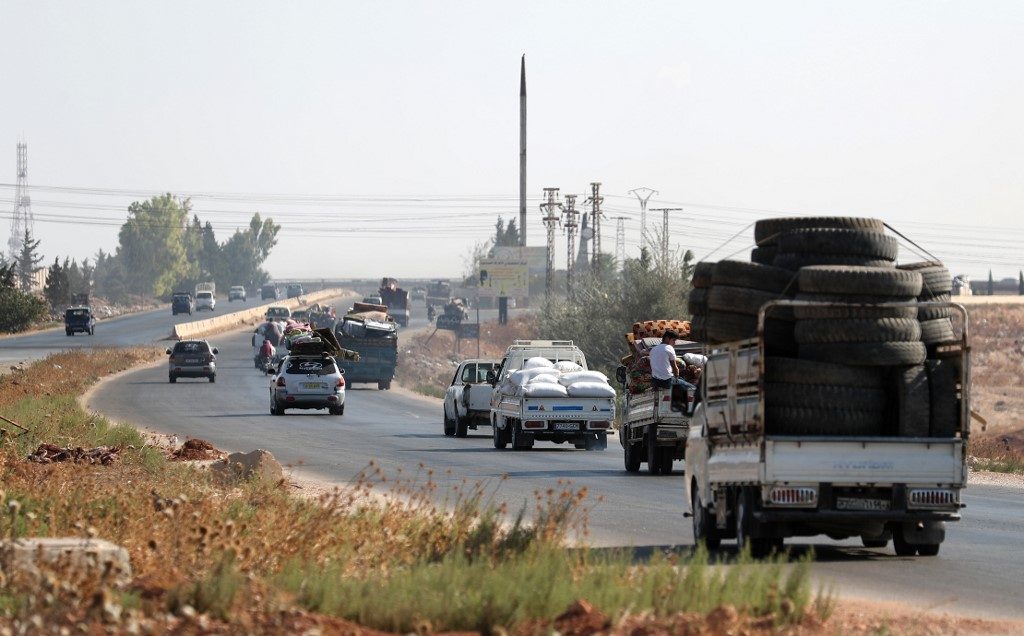SUMMARY
This is AI generated summarization, which may have errors. For context, always refer to the full article.

DAMASCUS, Syria – Damascus said Thursday, August 22, it is opening a corridor for civilians to leave the rebel-held northwestern region of Idlib, where government bombardment has killed hundreds since late April.
The announcement came a day after government forces recaptured the strategic Idlib province town of Khan Sheikhun from jihadists and allied rebels.
Damascus has opened such corridors out of other rebel bastions in the past as a prelude to retaking them either by force or through negotiated surrenders.
The Idlib region, which sits on the Turkish border, is now the last major stronghold of opposition to the Russia-backed government of President Bashar al-Assad.
Since January, it has been ruled by the Hayat Tahrir al-Sham alliance, which is led by jihadists from Syria’s former Al-Qaeda affiliate.
“The Syrian government announces the opening of a humanitarian corridor in Souran in the northern countryside of Hama province,” state news agency SANA quoted a foreign ministry source as saying.
The corridor will be used to evacuate “civilians who want to leave areas controlled by terrorists in northern Hama and the southern countryside of Idlib,” it added.
The government said it would provide shelter, food and medical care for civilians who chose to leave the region.
Civilians are often fearful about taking up government offers of refuge or safe passage for fear of arrest or conscription into the government’s depleted armed forces.
Besieged pocket
The advance on Wednesday, August 21, saw government forces cut off a pocket of territory stretching from the south of Idlib province into neighboring Hama, the Syrian Observatory for Human Rights said.
The pocket includes the town of Morek and the nearby areas of Kfar Zita and Latamneh.
The planned corridor will allow their remaining residents to escape into government-held territory, the Britain-based monitor said.
But most civilians had already fled before the pocket was cut off, Observatory head Rami Abdul Rahman told Agence France-Presse (AFP).
The encirclement of Morek has raised the stakes between the Russian-backed government and Turkey, which has troops manning an observation post in the town.
“Neither Damascus nor Moscow is likely interested in attacking a Turkish observation point in Idlib head-on, killing Turkish soldiers and provoking a more serious incident,” said Sam Heller of the International Crisis Group.
“But this latest advance has shown that they can simply advance around Turkish positions if they choose, reducing those Turkish observer forces to irrelevance.”
The recapture of Khan Sheikhun has long been a key government objective, as the town lies on the main highway through Idlib from Damascus to second city Aleppo.
‘No life here’
The region of some 3 million people was supposed to be protected by a proposed buffer zone agreed by Moscow and rebel backer Ankara last September.
But the jihadists of HTS failed to pull back from the zone as agreed and in April government and Russian forces resumed intense bombardment of the region.
Nearly 900 civilians have been killed, according to the Britain-based Observatory.
More than 400,000 more have fled their homes, the United Nations says.
On Thursday, government warplanes struck villages east of Maarat al-Numan, another key town on the Damascus-Aleppo highway, the Observatory said.
The goal of the bombardment is to force civilians to flee ahead of a push towards the rebel-held town, it added.
Abu Hussein fled his village outside Maarat al-Numan earlier this week, after heavy bombardment by Damascus and its Russian ally.
“Towns and villages are now empty of their residents,” he told AFP.
“There is no life here, you don’t see anything except warplanes launching strikes or helicopters dropping barrel bombs.”
The war in Syria has killed more than 370,000 people since it started with the brutal suppression of anti-government protests in 2011.
Rival interventions by outside powers have turned it into a complex conflict with multiple battle fronts that has driven millions of civilians from their homes. – Rappler.com
Add a comment
How does this make you feel?
There are no comments yet. Add your comment to start the conversation.